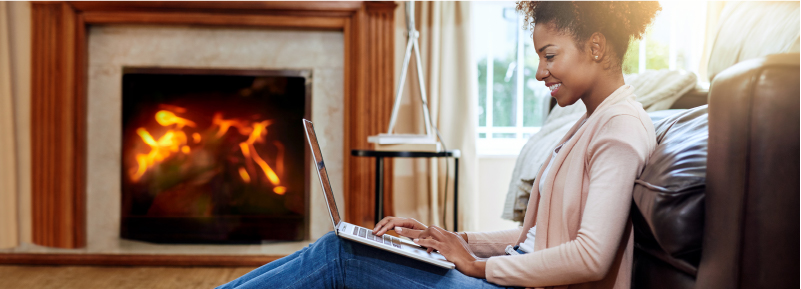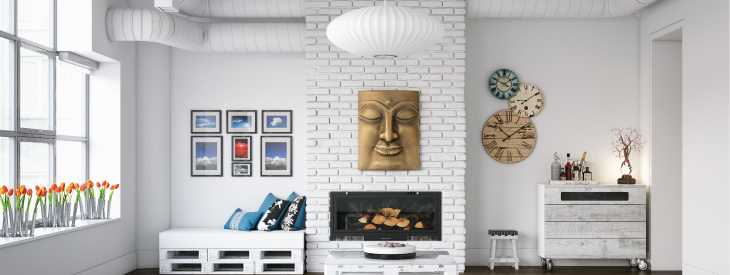
During the winter, your home’s interior comfort and energy bills can be greatly affected by relative humidity and fireplace use. Learn about the challenges posed by both and how to overcome the issues created by each..
Humidity
The term relative humidity (or RH) refers to the percentage of water vapor present in the air at a given temperature. For example, at 50 percent RH, the air is holding half of the moisture it’s capable of holding. The air’s capacity to hold water decreases as the temperature goes down and increases as the temperature goes up.
On a cold winter day, the weatherman may report that the outside temperature is 10°F with 70 percent humidity. When the cold outdoor air infiltrates a home and is heated to 72°F (22°C), it expands to four or five times its previous size. While the amount of moisture remains the same, the amount of humidity relative to the air volume (the RH) is reduced.
For example, when the outdoor temperature is 10°F (-12°C) and outdoor relative humidity is 70 percent, a home heated to 72°F (22°C) has an indoor humidity level of only 6 percent — much drier than the 25 percent relative humidity of the Sahara Desert!
The dry interior air will steal moisture from wherever it can find it, including your body! As moisture evaporates from your skin, you feel cooler. To counteract this sensation, it’s likely that you keep your thermostat turned up—an expensive habit, given the high cost of heating these days.
However, maintaining indoor relative humidity in the healthier more comfortable 35-to-45 percent range minimizes the air’s need to replenish moisture, and little or no evaporation from your body takes place. As a result, you can turn your thermostat down about 3 degrees and still maintain your former level of comfort and warmth. The energy cost savings over an entire heating season—let alone over multiple heating seasons—will be significant. According to the Department of Energy an average home spends approximately $600 for heating. Reducing the temperature by 3 degrees can save you 15 percent or $90 per year.
There are many ways to humidify the air in your home. You can use a simple single room humidifier, to installing a whole-house humidifier in your HVAC system. Typically, a whole-house humidifier can cost approximately $300 for a flow-thru type to over $600 for a steam type humidification. To control the humidity level in a home it is recommended to use a more accurate digital thermostat with humidity control for your HVAC system.
Fireplaces
Over 100 million homes, in North America are constructed with wood or gas-burning fireplaces. Unfortunately, there are negative side effects that the fireplace brings to a home, especially during the winter heating season.
Researchers have studied the amount of heat loss through a fireplace, and the results are amazing. One research study showed that an open damper on an unused fireplace in a well-insulated house can raise overall heating-energy consumption by up to 30 percent. According to the Department of Energy an average home spends approximately $600 for heating. Increasing energy usage by 30% increases your energy bill by $180 per year.
Testing conducted by a major laboratory revealed that between 80 percent and 90 percent of the heat produced by wood burned in an open fireplace is lost up the chimney. This means that for every $100 you spend for firewood, you get only $10 to $20 worth of heat. The rest goes up the chimney.
An open fireplace draws much more air than needed for combustion. As the large volume of air is drawn up the chimney, warm air from other areas of your house goes up the chimney, too. This steals heat from the other rooms and pulls cold air into the home through cracks around windows and doors and other leaky places that cannot be completely sealed off.
According to the U.S. Department of Energy, conventional fireplaces are one of the most inefficient heat sources, exhausting as much as 24,000 cubic feet of air per hour to the outside. All that warm air lost up the chimney must be replaced by cold air brought from outside and then reheated by the furnace.
Field trials conducted by the Combustion and Carbonization Research Laboratory (CCRL) of fireplaces in Canadian homes, in conjunction with other combustion equipment, have shown that in all but one case, on cold winter days, use of conventional masonry fireplaces actually resulted in an increase in fossil-fuel consumption for heating. The fireplaces actually had negative energy efficiency during the tests.
Why does a home with a fireplace have higher energy bills? Your chimney is an opening that leads directly outdoors — just like an open window. Even if the damper is shut, it is not airtight. An open or poorly sealed damper can draw air up the chimney even when the fireplace is not in use. This can occur during both heating and cooling seasons, creating a net energy loss on an annual basis.
So, how can you overcome inefficient fireplaces? An approximate 10-time improvement in heating efficiency can be made by installing an insulated fireplace insert. For standard fireplaces, adding a chimney cap damper to close the top of the chimney greatly reduces the amount of air that is able to enter the flue and draft into your home. Burning the right type of wood can help fires to burn hotter and longer, so only use seasoned firewood or hardwood logs to improve heating efficiency. Also, build ups of soot, even as little as 1/10 of an inch, on your flue can reduce the heat transfer of your fireplace by up to 50%. A professional chimney cleaning helps remedy this issue along with maintaining a good airflow in the flue for better burning fires.
By understanding the challenges that humidity and fireplaces can pose during the winter months, small adjustments to your HVAC system and fireplace efficiency can make a positive impact on the comfort and energy use in your home.
Read Next: Is Your Fireplace Burning Through your Energy Bill?


